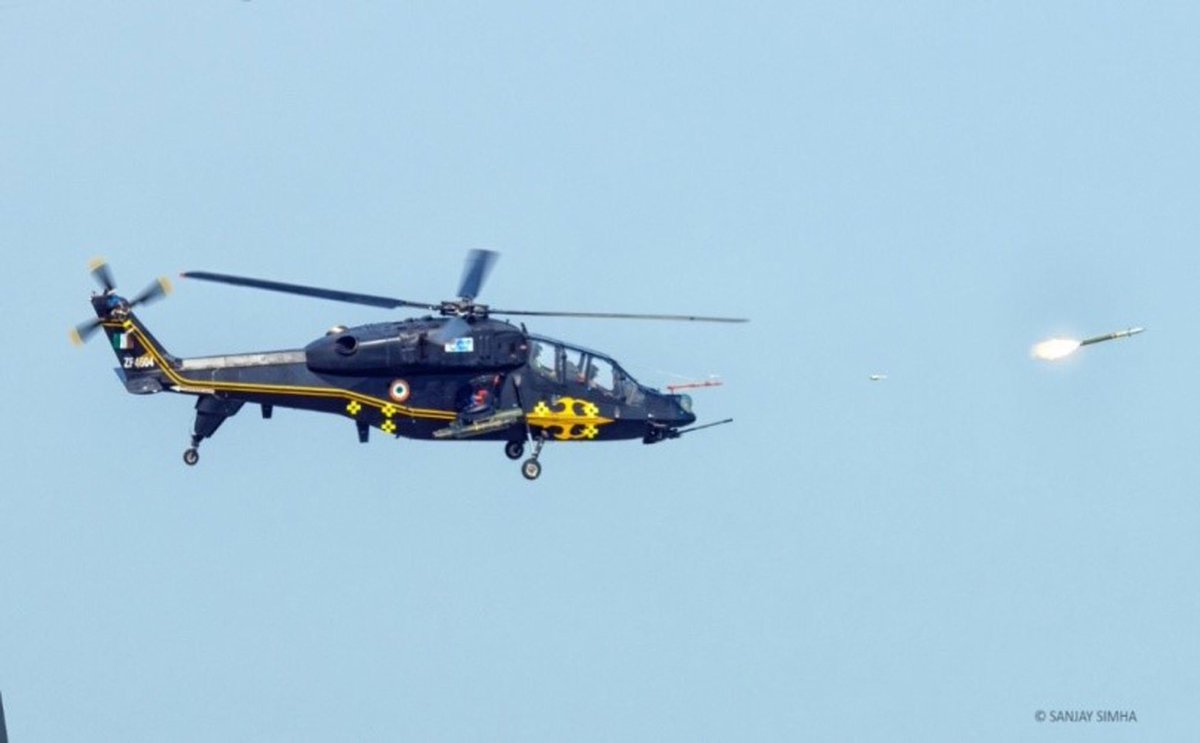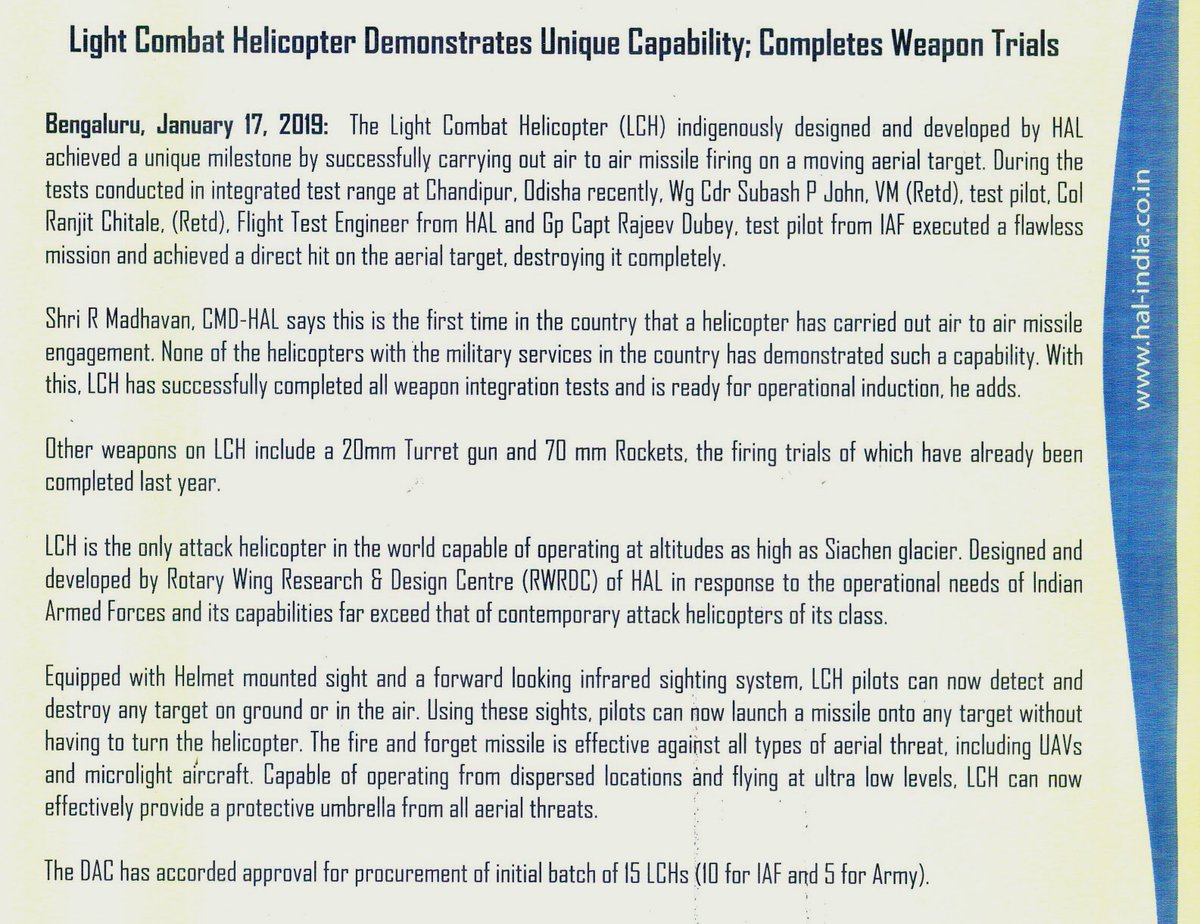cyclops
Senior Member
- Joined
- Apr 24, 2016
- Messages
- 1,319
- Likes
- 5,767
HAL seeks private partner to build Dhruv copters for civilian market

Thirty Dhruv helicopters built by HAL await collection by army and IAF, having been built ahead of time
By Ajai Shukla
(HAL) Bengaluru
Business Standard, 28th May 18
Hindustan Aeronautics (HAL) is readying a civilian version of its successful, twin-engine Dhruv Advanced Light Helicopter (ALH), hoping to grab a market for 300-500 civilian helicopters over the next 10 years, identified by consultants Frost & Sullivan.
Top HAL executives say that, by March 2019, its latest Mark III version of the Dhruv would be certified by the Directorate General of Civil Aviation (DGCA), clearing its use by central and state governments, hospitals, corporates and even private individuals.
“One of our key thrust areas this year was getting the Dhruv Mark III certified for civilian use by the DGCA. The Mark I is already certified, and clearing the Mark III requires certifying seven major changes to that configuration,” said HAL Chairman T Suvarna Raju.
With HAL’s helicopter complex in Bengaluru already working to capacity in building 72 Dhruv Mark III helicopters contracted by the army, navy and coast guard last October, HAL has floated an expression of interest (EoI), inviting the private sector to build the civilian Dhruv, with technology supplied by HAL.
Business Standard learns that the EoI has received 10 responses from private firms, including the Adani Group and Reliance. HAL is currently shortlisting eligible bidders, based on capability and capacity. Then, a winner will be selected based on commercial bidding.
HAL has welcomed the National Civil Aviation Policy of 2016 (NCAP-2016), which seeks to provide impetus to helicopter operations. Measures in the NCAP-2016 include allowing helicopters to fly from point-to-point without prior air traffic clearance in airspace below 5,000 feet in areas other than controlled airspace.
“NCAP-2016 has charged the DGCA with formulating a new helicopter policy, which I expect will boost the sector. When that happens, we will be ready with a fully certified civilian helicopter and a private sector production plant,” said Raju.
To also enable the Dhruv to compete in the international civilian helicopter market, HAL initiated a certification request four years ago with the European Aviation Safety Agency (EASA). HAL officials say EASA is at the final stages of granting certification for the civilian Dhruv.
However, HAL’s international fortunes could be adversely affected by its bad experience with Ecuador. Of the seven Dhruvs sold to that country, four crashed and the remaining three are grounded. While the Indian Air Force flies the same helicopter far more safely and successfully, aerospace experts say that the Dhruv has suffered in international perceptions.
Even so, HAL has achieved far greater success with helicopters than with fixed wing aircraft. Belying its reputation for delays, HAL has built 159 Dhruv ALHs, contracted in 2007, ahead of their schedule delivery in 2019.
The last 30 Dhruvs from this batch stand parked on the HAL tarmac in Bengaluru, ready for delivery. However, army and air force units are holding off collection until their personnel and infrastructure are ready.
Besides the current order for 72 more Dhruvs, HAL is also readying for building two other helicopters that it has developed. The army and IAF have ordered 15 Light Combat Helicopters, and are likely to follow up with a much heftier order when ‘final operational certification’ is granted later this year.
In addition, HAL is to build replacements for close to 400 obsolescent Cheetahs and Chetak helicopters that are still in military service. A joint venture between Russian Helicopters and HAL will build 197 Kamov-226T helicopters; and HAL will also build another 187 Light Utility Helicopters, which it has designed and developed.
The initial Dhruv ALH, called the Mark I, was powered by Safran TM 333-2B2 engines and had a conventional analogue cockpit. The Mark II version that followed had digital cockpit instrumentation. Major improvements came in the Mark III, with the Shakti engine, which was specially optimised for high-altitude operations. The Mark III also has an all-glass cockpit, electro-optic sensors, an electronic warfare suite, and flare and chaff dispensers.
Finally, as a precursor to the LCH, the Dhruv Mark IV was developed, which is an armed version of the Mark III. Dubbed the Rudra, this is armed – like the LCH –with anti-tank and air-to-air missiles, air-to-surface rockets and a 30-millimetre cannon.
https://ajaishukla.blogspot.com/2018/05/hal-seeks-private-partner-to-build.html?m=1
@Pulkit @abingdonboy

Thirty Dhruv helicopters built by HAL await collection by army and IAF, having been built ahead of time
By Ajai Shukla
(HAL) Bengaluru
Business Standard, 28th May 18
Hindustan Aeronautics (HAL) is readying a civilian version of its successful, twin-engine Dhruv Advanced Light Helicopter (ALH), hoping to grab a market for 300-500 civilian helicopters over the next 10 years, identified by consultants Frost & Sullivan.
Top HAL executives say that, by March 2019, its latest Mark III version of the Dhruv would be certified by the Directorate General of Civil Aviation (DGCA), clearing its use by central and state governments, hospitals, corporates and even private individuals.
“One of our key thrust areas this year was getting the Dhruv Mark III certified for civilian use by the DGCA. The Mark I is already certified, and clearing the Mark III requires certifying seven major changes to that configuration,” said HAL Chairman T Suvarna Raju.
With HAL’s helicopter complex in Bengaluru already working to capacity in building 72 Dhruv Mark III helicopters contracted by the army, navy and coast guard last October, HAL has floated an expression of interest (EoI), inviting the private sector to build the civilian Dhruv, with technology supplied by HAL.
Business Standard learns that the EoI has received 10 responses from private firms, including the Adani Group and Reliance. HAL is currently shortlisting eligible bidders, based on capability and capacity. Then, a winner will be selected based on commercial bidding.
HAL has welcomed the National Civil Aviation Policy of 2016 (NCAP-2016), which seeks to provide impetus to helicopter operations. Measures in the NCAP-2016 include allowing helicopters to fly from point-to-point without prior air traffic clearance in airspace below 5,000 feet in areas other than controlled airspace.
“NCAP-2016 has charged the DGCA with formulating a new helicopter policy, which I expect will boost the sector. When that happens, we will be ready with a fully certified civilian helicopter and a private sector production plant,” said Raju.
To also enable the Dhruv to compete in the international civilian helicopter market, HAL initiated a certification request four years ago with the European Aviation Safety Agency (EASA). HAL officials say EASA is at the final stages of granting certification for the civilian Dhruv.
However, HAL’s international fortunes could be adversely affected by its bad experience with Ecuador. Of the seven Dhruvs sold to that country, four crashed and the remaining three are grounded. While the Indian Air Force flies the same helicopter far more safely and successfully, aerospace experts say that the Dhruv has suffered in international perceptions.
Even so, HAL has achieved far greater success with helicopters than with fixed wing aircraft. Belying its reputation for delays, HAL has built 159 Dhruv ALHs, contracted in 2007, ahead of their schedule delivery in 2019.
The last 30 Dhruvs from this batch stand parked on the HAL tarmac in Bengaluru, ready for delivery. However, army and air force units are holding off collection until their personnel and infrastructure are ready.
Besides the current order for 72 more Dhruvs, HAL is also readying for building two other helicopters that it has developed. The army and IAF have ordered 15 Light Combat Helicopters, and are likely to follow up with a much heftier order when ‘final operational certification’ is granted later this year.
In addition, HAL is to build replacements for close to 400 obsolescent Cheetahs and Chetak helicopters that are still in military service. A joint venture between Russian Helicopters and HAL will build 197 Kamov-226T helicopters; and HAL will also build another 187 Light Utility Helicopters, which it has designed and developed.
The initial Dhruv ALH, called the Mark I, was powered by Safran TM 333-2B2 engines and had a conventional analogue cockpit. The Mark II version that followed had digital cockpit instrumentation. Major improvements came in the Mark III, with the Shakti engine, which was specially optimised for high-altitude operations. The Mark III also has an all-glass cockpit, electro-optic sensors, an electronic warfare suite, and flare and chaff dispensers.
Finally, as a precursor to the LCH, the Dhruv Mark IV was developed, which is an armed version of the Mark III. Dubbed the Rudra, this is armed – like the LCH –with anti-tank and air-to-air missiles, air-to-surface rockets and a 30-millimetre cannon.
https://ajaishukla.blogspot.com/2018/05/hal-seeks-private-partner-to-build.html?m=1
@Pulkit @abingdonboy






